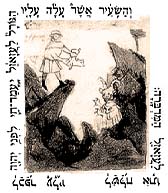|


The ancient biblical rite performed by the priests
on the Day of Atonement including the dispatching of a goat to Azazel, to carry
off the collective sins of the people, described in Leviticus 16.[1]
The goat sent to Azazel served not only as a public ridding of the people's
sins, but as a public acknowledgment by the community of its transgressions.
In modern usage, "scapegoat" came to refer to an individual whom people
blame for their own misfortunes or failings.
The English term "scapegoat" was coined
by William Tyndale, the first to translate the Hebrew Bible into English. The
concept of a person, animal or object to whom the impurity or guilt of a community
was formally transferred and then removed, is found among many ancient peoples;
often that figure was a goat. In Babylonia, it was customary to give a goat
as a substitute for a human being to Ereshkigal, the goddess of the abyss. In
an Akkadian magical inscription from the city of Assur which deals with the
cure for a man who is unable to eat and drink, it is prescribed that a goat
should be tied to his bed and that thus the sickness will pass to the goat;
on the following morning, the goat is to be taken to the desert and decapitated.
 During
periods of plagues, the ancient Hittites used to send a goat into enemy territory
in order that it should carry the plague there; on the head of the goat they
would bind a crown made of colored wool. This custom recalls the Israelite ritual
as performed during Second Temple times: the High Priest drew lots and tied
a thread of crimson wool onto the head of the goat chosen for Azazel.[2]
In the Hellenistic world there were also "scapegoat" rituals, but
humans and not animals were sent out of the city and sometimes even killed. During
periods of plagues, the ancient Hittites used to send a goat into enemy territory
in order that it should carry the plague there; on the head of the goat they
would bind a crown made of colored wool. This custom recalls the Israelite ritual
as performed during Second Temple times: the High Priest drew lots and tied
a thread of crimson wool onto the head of the goat chosen for Azazel.[2]
In the Hellenistic world there were also "scapegoat" rituals, but
humans and not animals were sent out of the city and sometimes even killed.
There is a great deal of confusion regarding the
exact meaning of the word "Azazel." Most scholars agree that in ancient times,
it referred to a demonic power residing in the desert (whose abode was regarded
as a focus of impurity) or alternatively, to the abode itself. As the wilderness
was widely held to be the habitat of demons[3],
we can understand how the original purpose of the ritual might have been to
get rid of evil by banishing it to its original source. Twelfth century grammarian
David Kimhi[4] associates the word Azazel
with the mountain to which the goat was taken.
The goat which was dispatched to Azazel was not intended to be a sacrifice,
as it was not slaughtered. "And Aaron shall cast lots upon the two goats;
one lot for the Lord, and the other for Azazel. And Aaron shall present the
goat upon which the lot feel for the Lord, and offer him for a sin-offering.
But the goat, on which the lot fell for Azazel, shall be set alive before the
Lord, to make atonement over him, to send him away for Azazel into the wilderness."[5].
The two goats recall the birds mentioned also in Leviticus, in which one of
the two birds is set free to fly over the field.[6]
And yet, according to the description in
the Mishnah, during the Second Temple period, a priest specially qualified to
do so was responsible for pushing the goat backward over a cliff.[7]
While the death of the goat was not indispensable, as the High Priest could
continue the divine service once the goat was dispatched without having to wait
for the goat to be killed, it is possible that this custom evolved so as to
avoid the possibility that the goat return to inhabited places, laden with sin.
|
[1]
Lev. 16:10, 21-22. [back]
[2] Mishnah, Yoma 4:2 [back]
[3] Lev. 13:21, 34:14, 17:7 [back]
[4] Commentator and grammarian David Kimhi (c.1160-1235)
wrote a grammar book/dictionary called Book of Roots [back]
[5] Lev. 16:8-10 [back]
[6] Lev. 14:4-7 [back]
[7] Mishnah, Yoma 6:3 [back] |
GOATS Table of Contents
|